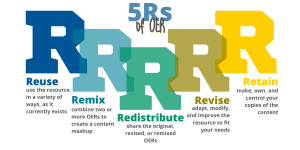Phone: (888) 628-1569
Text/SMS: (928) 550-6552
Email: library@ncu.edu
FAQs: nu.libanswers.com
 Library Staffed Hours
Library Staffed HoursHours shown below are Pacific Time. Check your local time here.
Monday - Thursday
8:00 AM - 9:00 PM
Friday
8:00 AM - 5:00 PM
Saturday
9:00 AM - 5:00 PM
Sunday
10:00 AM - 9:00 PM
Please see the library calendar for holiday closings/adjusted hours.
"OER are teaching, learning, and research resources that reside in the public domain or have been released under an intellectual property license that permits their free use and re-purposing by others. Open educational resources include full courses, course materials, modules, textbooks, streaming videos, tests, software, and any other tools, materials, or techniques used to support access to knowledge." [1]
The Open Education movement is built around the 5Rs of Openness: [2]

5RS of OER by O'Neil et al.is licensed under CC BY-NC-SA 4.0
OER are educational materials that are specifically designed by their creator/s to be openly available, and are often licensed to be re-used, re-mixed, and re-distributed. Open is not just about low cost (though that is an important benefit of using OER) but about the ability to take what others have created, customize it for your specific educational needs, and then share your creation with others.
OER come in a variety of forms:
Why OER?
The open resource movement has been around for a while, starting with static learning objects (about 2000), and transitioning to OER that allowed for revision and reuse. It is the ever-increasing cost of textbooks and materials for students that is now pushing the OER movement forward. Textbooks and learning materials cost students approximately $1,200 per year. According to the Chronicle of Higher Education, 7 in 10 students didn't purchase a textbook because it was too expensive. Through OER the cost of student materials can be drastically reduced. OER also gives instructors the ability to customize the materials, creating the "perfect" textbook instead of being bound to traditional print resources.
In 2023 alone, the use of open educational resources, saved National University students almost $250,000 on textbooks.
© Copyright 2025 National University. All Rights Reserved.